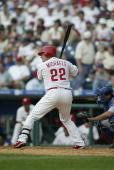The loss of Coco Crisp, especially in a starting outfield that still includes Casey Blake, is not a good thing. Although, in making this trade, the Indians may have found a suitable replacement for Coco.
Michaels has been a part-time player for the Phillies the last two years, but a big reason for that is they had Pat Burrell in LF, Bobby Abreu in RF and super prospect Marlon Byrd and Kenny Lofton in CF. Michaels was the odd man out.
Indians fans will know that Brian Giles was once in the same situation in Cleveland a few years back. With David Justice in LF, Manny Ramirez in RF, and Kenny Lofton and Marquis Grisson in CF, Giles was relegated to a platoon status. Giles was traded, and once he got his shot as an everyday player, he flourished.
In no way are we saying that Michaels is of Giles caliber, but that sometimes a player is not always a 4th outfielder “for a reason.” Sometimes they are in such a role because of the situation they are in. Crisp was once the Indians 4th outfielder in 2004, but when given the chance to play everyday, he jumped on it. Michaels could possibly do the same thing.
Over their short careers, they have proven to be very similar production-wise. The difference is, Crisp got a shot on a rebuilding team with no established stars, while Michaels has been stuck behind several stars and big Philly prospects. A look at their 2005 numbers, major league career, and minor league career:
2005
Crisp: .300/.345/.465/.810 with 16 HRs and 69 RBIs in 594 at bats
Michaels: 304/.399/.415/.814 with 4 HRs and 31 RBIs in only 289 at bats
MLB Career
Crisp: .287/.332/.424/.756 with 35 HRs and 176 RBIs in 1626 at bats
Michaels: .291/.380/.442/.822 with 21 HRs and 100 RBIs in 808 at bats
Minor League Career
Crisp: .299/.374/.411/.785 with 25 HRs and 167 RBIs in 1624 at bats
Michaels: .282/.359/.461/.820 with 52 HRs and 264 RBIs in 1587 at bats
Michaels has been just as productive as Crisp, in fact his .380 career on-base percentage vs. Crisp’s .332 show that Michaels may actually help the middle of the order produce more runs as he will get on base more. Also, if you extrapolate Michaels production in 289 at bats to Crisp’s 594 at bats in 2005, Michaels would have projected to .304/8/63. Michaels career numbers in the majors and minors are on par with Crisp’s numbers as well.
Baseball Prospectus recently released their PECOTA projections this past week. Their projections tool is considered among fans and baseball
executives as one of the best available. Also, the Indians supposedly subscribe to a lot of what Baseball Prospectus says in their analysis. In
any case, here are the 2006 projections for Michaels and Crisp:
2006 PECOTA Projections
Crisp: .295/.347/.445/.792 with 15 HRs and 76 RBIs in 662 plate appearances
Michaels: .283/.374/.445/.819 with 10 HRs and 46 RBIs in 380 plate appearances
Of course, Michaels should get much more than 380 plate appearances. Paying no regard to Baseball Prospectus’ PECOTA formula, if you extrapolate his 380 plate appearances to Crisp’s 662 plate appearances, you get 17 HRs and 80 RBIs. Again, as has been noted with their minor league and major league history, they project as pretty much the same offensively in 2006.
Defensively, Crisp and Michaels are rated pretty close. Michaels has the stronger arm, which allows him to play any outfield position. Crisp can cover more ground because of his speed, but ideally can't play RF because of his arm. Out of all the outfielders in baseball, Hardball Times had Crisp rated as the 14th best outfielder and Michaels the 24th best outfielder in 2005.
Now, if this is the case, why didn't the Red Sox just trade Mota for Michaels instead of dealing Mota and two strong prospects for Crisp? Well, Crisp does bring a “name” and also is almost 4 years younger, so long term Crisp is the better player. However, for the short term, Michaels is a very capable replacement for Crisp. The long-term solution in LF may end up being Brad Snyder or Franklin Gutierrez, two heralded prospects in the Indians system. It is also not out of the realm of possibility that the Indians make another trade down the road, or make a free agent signing to fill the LF void for 2007 (or even 2006) and beyond.
In the end, with Michaels, you are gaining a player who will work more counts and get on base more. With Crisp, you are getting a player who will provide a little more pop and also provide more speed on the bases.
It is unclear how Michaels will produce in an increased role, but as a part time player for the Phillies his production was on par with Crisp’s. The end result, is this is not nearly the loss or downgrade that fans may be thinking. Shapiro did a good job in finding a suitable replacement for Crisp in 2006.
Tomorrow, we will look at Andy Marte and what he brings to the table for the Indians in 2006 and beyond.